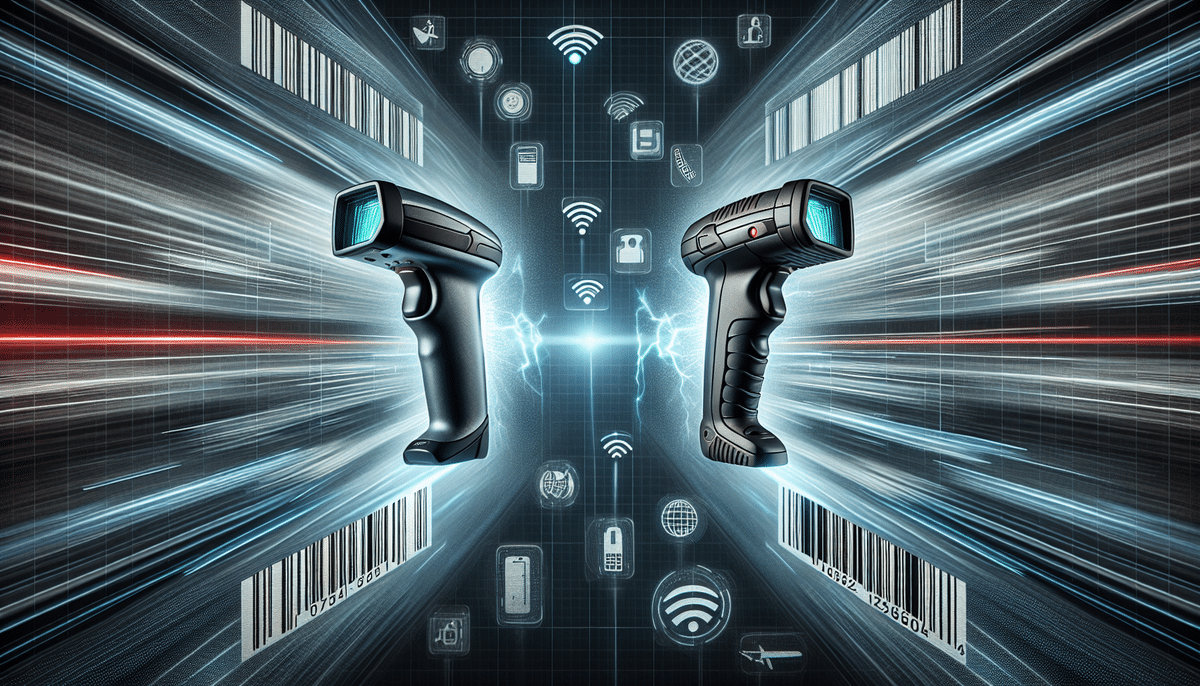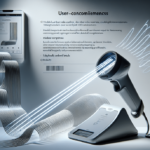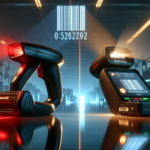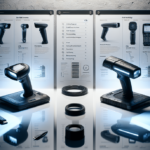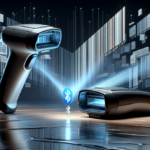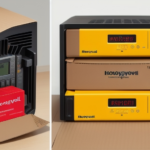Honeywell Voyager 1200g vs Datalogic Gryphon I GD4500: Comprehensive Comparison for 2024
If you're in the market for a barcode scanner, you may have come across the Honeywell Voyager 1200g and the Datalogic Gryphon I GD4500. Both are top-tier options offering reliable scanning capabilities, but which one is the better choice for your specific needs? In this article, we'll provide an in-depth comparison to help you make an informed decision based on technical specifications, design, performance, scanning capabilities, ease of use, price, pros and cons, customer reviews, expert opinions, and future developments in barcode scanning technology.
A Brief Overview of the Honeywell Voyager 1200g and Datalogic Gryphon I GD4500
The Honeywell Voyager 1200g and the Datalogic Gryphon I GD4500 are handheld laser scanners designed for general-purpose scanning applications across various industries such as retail, healthcare, and office environments. The Honeywell Voyager 1200g is engineered to be lightweight and ergonomic, ensuring comfortable all-day use, while the Datalogic Gryphon I GD4500 boasts a ruggedized construction tailored for durability in demanding environments.
Both scanners effectively read standard 1D barcodes. Additionally, the Datalogic Gryphon I GD4500 can interpret stacked and composite codes, enhancing its versatility in complex scanning scenarios.
Beyond standard barcode reading, the Honeywell Voyager 1200g features patented CodeGate technology, enabling users to target desired barcodes effortlessly and complete data transmission with a single button press. On the other hand, the Datalogic Gryphon I GD4500 incorporates advanced motion-sensing technology that automatically toggles between handheld and presentation modes, catering to both handheld and hands-free scanning needs.
Technical Specifications of Honeywell Voyager 1200g and Datalogic Gryphon I GD4500
Understanding the technical specifications is crucial in determining which scanner best fits your operational requirements. Below is a detailed comparison of both models:
- Honeywell Voyager 1200g:
- Scanning Speed: 100 scans per second
- Depth of Field: 0.5 to 15 inches
- Reading Distance: Up to 23 inches
- Minimum Barcode Width: 4 mils
- Interfaces: USB, RS-232, Keyboard Wedge
- Additional Features: CodeGate technology
- Datalogic Gryphon I GD4500:
- Scanning Speed: 325 scans per second
- Depth of Field: 0.4 to 14 inches
- Reading Distance: Up to 42 inches
- Minimum Barcode Width: 3 mils
- Interfaces: USB, RS-232, Keyboard Wedge, IBM 46xx
- Additional Features: Motion-sensing technology
Both scanners come equipped with multi-interface capabilities, allowing seamless connectivity to various devices such as laptops, tablets, and smartphones. The Honeywell Voyager 1200g supports USB, RS-232, and Keyboard Wedge interfaces, whereas the Datalogic Gryphon I GD4500 offers additional IBM 46xx interface support. Furthermore, the Datalogic Gryphon I GD4500 is built to endure multiple drops from heights up to 6 feet, making it a reliable choice for rugged environments.
Design Comparison between Honeywell Voyager 1200g and Datalogic Gryphon I GD4500
The physical design of a barcode scanner significantly impacts user comfort and efficiency. Here's how the two models compare:
- Honeywell Voyager 1200g:
- Design: Sleek and lightweight, promoting comfort during extended use.
- Operation: Features a single-button scanning operation for simplicity.
- Hands-Free Capability: Includes a stand for hands-free scanning applications.
- Additional Features: Optimized for reading barcodes from a distance, ideal for high shelves or hard-to-reach areas.
- Feedback: Equipped with LED indicators providing clear feedback on scan status.
- Datalogic Gryphon I GD4500:
- Design: Ruggedized construction engineered to withstand drops, shocks, and falls.
- Operation: Features a four-position scan trigger for customizable scanning experiences.
- Hands-Free Capability: Comes with a stand and advanced motion-sensing technology that automatically switches between scanning modes.
- Ergonomics: Ergonomically designed to reduce hand fatigue, enhancing productivity during long scanning sessions.
The Honeywell Voyager 1200g's ergonomic, lightweight design makes it exceptionally comfortable for all-day use, while the Datalogic Gryphon I GD4500's rugged build ensures durability in challenging environments. Additionally, the Datalogic Gryphon I GD4500's motion-sensing technology offers advanced functionality for dynamic scanning needs.
Performance Comparison of Honeywell Voyager 1200g and Datalogic Gryphon I GD4500
When evaluating barcode scanners, performance metrics such as scanning speed, range, and reliability are critical. Here's how the two models stack up:
- Scanning Speed: The Datalogic Gryphon I GD4500 outperforms the Honeywell Voyager 1200g with a scanning speed of 325 scans per second compared to 100 scans per second. This makes the Gryphon ideal for high-volume environments where speed is essential.
- Scanning Range: The Datalogic Gryphon I GD4500 offers a broader reading distance of up to 42 inches, whereas the Honeywell Voyager 1200g can read up to 23 inches. The extended range of the Gryphon is particularly beneficial in large warehouses or retail settings with high shelving.
- Barcode Reading: Both scanners efficiently read standard 1D barcodes, but the Datalogic Gryphon I GD4500 excels in reading stacked and composite codes, providing greater flexibility in complex scanning environments.
- Ergonomics and User Comfort: While the Gryphon offers superior speed and range, the lightweight and ergonomic design of the Honeywell Voyager 1200g ensures better user comfort during prolonged use.
In summary, the Datalogic Gryphon I GD4500 provides enhanced performance suitable for high-demand settings, whereas the Honeywell Voyager 1200g offers balanced performance with greater ergonomic benefits.
Scanning Capabilities of Honeywell Voyager 1200g and Datalogic Gryphon I GD4500
The ability to accurately scan various barcode types determines a scanner's versatility. Here's an overview of the scanning capabilities of the two models:
- Supported Barcode Symbologies:
- Honeywell Voyager 1200g: Supports a wide range of 1D barcodes including Code 39, Code 128, UPC/EAN, and RSS.
- Datalogic Gryphon I GD4500: In addition to all 1D barcodes supported by the Voyager 1200g, it can also read stacked and composite codes, enhancing its functionality in complex scanning environments.
- Digital Watermark Scanning: Both scanners are equipped to scan digital watermarks, which is particularly useful in industries like pharmaceuticals and luxury goods where product authenticity is critical.
- Advanced Imaging Technology:
- The Datalogic Gryphon I GD4500 leverages advanced imaging technology, enabling it to read barcodes from up to 1 meter away. This capability is advantageous in expansive settings like warehouses and distribution centers where items may be stored on high shelves.
The Datalogic Gryphon I GD4500's enhanced barcode reading capabilities, including stacked and composite code recognition and extended scanning distance, make it a versatile tool for diverse scanning requirements.
Ease of Use Comparison between Honeywell Voyager 1200g and Datalogic Gryphon I GD4500
Usability is paramount in ensuring productivity and minimizing user fatigue. Here's how the two scanners compare in terms of ease of use:
- Honeywell Voyager 1200g:
- Simplicity: Features single-button scanning operation, making it straightforward and user-friendly, especially for employees without extensive training.
- Ergonomics: Lightweight and ergonomically designed for comfortable handling during extended scanning sessions.
- Datalogic Gryphon I GD4500:
- Advanced Features: Offers more customization options with a four-position scan trigger, catering to specific operational needs.
- Motion-Sensing Technology: Automatically switches between handheld and hands-free modes, reducing the need for manual adjustments and enhancing scanning efficiency.
- Multi-Interface Support: Compatibility with various interfaces allows for flexible integration into existing systems.
Overall, the Honeywell Voyager 1200g excels in simplicity and comfort, making it ideal for general-purpose use. In contrast, the Datalogic Gryphon I GD4500 offers advanced functionalities and customization that cater to more specific user requirements.
Price Comparison between Honeywell Voyager 1200g and Datalogic Gryphon I GD4500
Price is a critical factor in decision-making, especially for businesses assessing budget constraints and value for money. Here's a comparison:
- Honeywell Voyager 1200g: Priced at approximately $99, the Voyager 1200g offers an affordable solution with reliable scanning capabilities, making it an attractive option for small to medium-sized businesses.
- Datalogic Gryphon I GD4500: With a price tag of around $250, the Gryphon I GD4500 is a premium model that commands a higher investment. Its superior performance, extended durability, and advanced features justify the increased cost for organizations requiring robust scanning solutions.
While the Datalogic Gryphon I GD4500 is more expensive, its enhanced scanning speed, greater reading distance, and durable construction make it a worthwhile investment for high-demand environments. Conversely, the Honeywell Voyager 1200g presents a cost-effective alternative for businesses that need dependable scanning without the additional expense of advanced features.
Additionally, both scanners offer various connectivity options such as USB and, in the case of the Gryphon I GD4500, Bluetooth, which can influence the total cost based on the specific connectivity requirements of the user.
Pros and Cons of Using Honeywell Voyager 1200g for Barcode Scanning
The Honeywell Voyager 1200g is a popular choice among businesses seeking a balance between affordability and performance. Here's a breakdown of its advantages and disadvantages:
- Pros:
- Lightweight and Ergonomic Design: Ensures comfort during extended use.
- Affordable Price: Priced around $99, offering excellent value for money.
- Reliable Scanning Performance: Consistently reads standard 1D barcodes efficiently.
- Ease of Use: Single-button operation simplifies scanning tasks for all users.
- Versatile Scanning Distance: Capable of reading barcodes from a distance, beneficial for various applications.
- Cons:
- Limited Range and Speed: Slower scanning speed and shorter reading distance compared to higher-end models like the Gryphon I GD4500.
- Basic Features: Lacks advanced functionalities such as motion-sensing technology and support for stacked/composite codes.
- No Wireless Connectivity: Does not offer Bluetooth or Wi-Fi options, which may limit mobility.
- Not Ideal for High-Volume Scanning: May not be suitable for environments that require rapid and extensive scanning operations.
Despite some limitations, the Honeywell Voyager 1200g remains a robust and user-friendly option for businesses with general scanning needs and budget considerations.
Additionally, its capability to read barcodes from mobile devices, such as smartphones and tablets, adds to its versatility in modern business settings.
However, the absence of wireless connectivity can be a drawback for organizations seeking greater flexibility in scanner placement and mobility.
Pros and Cons of Using Datalogic Gryphon I GD4500 for Barcode Scanning
The Datalogic Gryphon I GD4500 is designed for demanding environments that require high performance and durability. Here's an analysis of its strengths and weaknesses:
- Pros:
- Superior Scanning Speed and Range: With 325 scans per second and a reading distance of up to 42 inches, it's ideal for high-volume scanning needs.
- Ruggedized Construction: Built to withstand drops, shocks, and falls, ensuring longevity in harsh environments.
- Versatile Barcode Reading: Capable of reading stacked and composite codes, expanding its application range.
- Motion-Sensing Technology: Automatically switches between handheld and hands-free modes, enhancing operational efficiency.
- Omnidirectional Reading Capability: Allows quick and easy scanning from any angle, reducing user effort.
- Cons:
- Higher Price Tag: At around $250, it requires a greater initial investment compared to other models.
- Heavier and Bulkier Design: May lead to user discomfort during extended use sessions.
- Software Compatibility Issues: Some users report challenges integrating the Gryphon with existing software systems, potentially leading to additional support costs.
- Complex Features: The advanced functionalities may be unnecessary for businesses with basic scanning needs, leading to underutilization of its capabilities.
While the Datalogic Gryphon I GD4500 offers exceptional performance and durability, its higher cost and weight may be considerations for businesses with simpler or budget-constrained scanning requirements.
Nonetheless, its advanced features like motion-sensing technology and omnidirectional reading enhance productivity and make it a valuable asset for high-demand settings.
Which One Should You Choose: Honeywell Voyager 1200g or Datalogic Gryphon I GD4500?
Choosing between the Honeywell Voyager 1200g and the Datalogic Gryphon I GD4500 ultimately hinges on your specific operational requirements and budget considerations. Here are some guiding factors to help you decide:
- Operational Volume:
- If your business involves high-volume scanning, such as in large retail operations or warehouses, the Datalogic Gryphon I GD4500 is better suited due to its superior scanning speed and extended range.
- For moderate to low-volume scanning tasks, the Honeywell Voyager 1200g offers sufficient performance without the higher cost.
- Environment:
- In demanding environments where durability is paramount, the ruggedized Datalogic Gryphon I GD4500 is the preferable choice.
- For standard office or retail settings, the Honeywell Voyager 1200g's lightweight and ergonomic design is more appropriate.
- Budget:
- The Honeywell Voyager 1200g is a cost-effective option for businesses with budget constraints.
- The Datalogic Gryphon I GD4500, while pricier, offers advanced features and enhanced durability that can translate into long-term savings in high-demand applications.
- Feature Requirements:
- If advanced functionalities such as motion-sensing, omnidirectional reading, and the ability to read complex barcodes are necessary, the Datalogic Gryphon I GD4500 is the superior choice.
- For users who prioritize simplicity and ease of use, the Honeywell Voyager 1200g is more suitable.
In summary, if your operations demand high performance and durability, and you have the budget for it, the Datalogic Gryphon I GD4500 is the ideal selection. Conversely, for general-purpose scanning needs with a focus on cost-effectiveness and ergonomic design, the Honeywell Voyager 1200g stands out as the better choice.
Customer Reviews of Honeywell Voyager 1200g vs Datalogic Gryphon I GD4500
Feedback from actual users provides valuable insights into the real-world performance and reliability of barcode scanners. Here's a summary of customer sentiments for both models:
- Honeywell Voyager 1200g:
- Reliability: Users consistently praise the Voyager 1200g for its dependable scanning performance and minimal downtime.
- Ease of Use: The single-button operation and lightweight design are highlighted as major benefits, especially for businesses with employees who may lack extensive training in barcode scanning.
- Affordability: Many customers appreciate the scanner's affordability without compromising on essential functionalities.
- Minor Drawbacks: Some users mention the limited range and absence of wireless connectivity as limitations, particularly in larger or more dynamic environments.
- Datalogic Gryphon I GD4500:
- Performance: Users commend the Gryphon I GD4500 for its exceptional scanning speed and ability to handle complex barcodes, making it a valuable asset in high-throughput settings.
- Durability: The rugged construction receives positive remarks for withstanding rigorous use and accidental drops.
- Advanced Features: Customers value the motion-sensing technology and hands-free scanning capabilities, which enhance operational efficiency.
- Concerns: Some users note the scanner's weight and bulkiness as potential issues for long-term comfort, and a few have experienced compatibility issues with certain software systems.
Overall, both the Honeywell Voyager 1200g and the Datalogic Gryphon I GD4500 receive highly positive reviews for their respective strengths. The Voyager is lauded for its affordability and user-friendly design, making it suitable for a wide range of applications. In contrast, the Gryphon I GD4500 is celebrated for its superior performance and durability, catering to more demanding operational needs.
Expert Opinions on the Performance, Durability, and Overall Quality of These Scanners
Industry experts and technology reviewers have analyzed the Honeywell Voyager 1200g and the Datalogic Gryphon I GD4500, offering professional assessments of their capabilities:
- Performance:
- Honeywell Voyager 1200g: Experts highlight the Voyager 1200g's reliable scanning speed and accurate barcode reading capabilities, making it a solid choice for businesses needing dependable performance.
- Datalogic Gryphon I GD4500: The Gryphon I GD4500 is praised for its superior scanning speed and extended range, positioning it as the preferred option for high-volume and complex scanning environments.
- Durability:
- Honeywell Voyager 1200g: While not as rugged as the Gryphon, the Voyager 1200g is appreciated for its solid build quality that ensures longevity under regular use.
- Datalogic Gryphon I GD4500: The Gryphon's rugged design is a standout feature, with experts confirming its ability to withstand harsh conditions and frequent handling without compromising performance.
- Overall Quality:
- Honeywell Voyager 1200g: Lauded for providing excellent value, the Voyager 1200g's combination of affordability and reliability makes it a favored choice among small to medium-sized enterprises.
- Datalogic Gryphon I GD4500: Recognized for its high-end performance and durability, the Gryphon I GD4500 earns recommendations for industries that demand robust and efficient scanning solutions.
- Future-Proofing:
- Experts note that the Datalogic Gryphon I GD4500's advanced features and adaptability make it more future-proof, capable of integrating with emerging technologies and evolving business needs.
- The Honeywell Voyager 1200g, while slightly more basic, remains a reliable option as barcode technology standards continue to be essential across various sectors.
In conclusion, expert evaluations commend both scanners for their particular strengths, with the Honeywell Voyager 1200g being ideal for cost-conscious businesses seeking reliable performance, and the Datalogic Gryphon I GD4500 being recommended for organizations requiring high performance and durability in demanding environments.
A Look at the Future Developments in Barcode Scanning Technology
The barcode scanning industry is continuously evolving, driven by advancements in technology and changing business needs. Here are some key trends and future developments shaping the future of barcode scanning:
- 2D Imaging Scanners: The adoption of 2D imaging technology is increasing, allowing scanners to read more complex barcodes and capture broader data points. This enhances scanning accuracy and efficiency, especially in environments with challenging barcode conditions. Forbes Tech Council discusses these advancements in detail.
- Near-Field Communication (NFC): Integration of NFC technology is enabling contactless scanning and secure data transmission. This is particularly beneficial in industries like retail and logistics, where speed and security are paramount. According to a study by NCBI, NFC integration enhances operational efficiency.
- Artificial Intelligence (AI) and Machine Learning: AI-driven scanners are becoming more intelligent, capable of recognizing and interpreting a wide variety of barcode formats and adapting to different scanning scenarios automatically. Forbes highlights the role of AI in barcode scanning.
- Wireless and Mobile Integration: Future scanners are expected to offer enhanced wireless capabilities, including improved Bluetooth and Wi-Fi connectivity, facilitating greater mobility and seamless integration with mobile devices and cloud-based systems. TechRepublic explores these integration trends.
- Enhanced Durability: Manufacturers are focusing on developing more durable scanners that can withstand harsher environments, making them suitable for an even broader range of applications. Insights from Business Insider elaborate on durability enhancements.
- Improved Battery Life: Advances in battery technology are leading to longer-lasting scanners, reducing downtime and increasing productivity in operations that rely heavily on mobile scanning devices.
- IoT Integration: The Internet of Things (IoT) is paving the way for interconnected devices within supply chains, allowing scanners to communicate and share data in real-time for streamlined operations and better inventory management. IoT For All discusses the impact of IoT on barcode scanning.
These developments point towards a future where barcode scanners are more versatile, intelligent, and seamlessly integrated into broader technological ecosystems, enhancing their role in optimizing business processes and improving operational efficiency.
How to Properly Care for Your Barcode Scanner to Ensure Long-Lasting Performance
Proper maintenance and care are essential to prolong the lifespan and maintain the optimal performance of your barcode scanners. Here are some best practices:
- Regular Cleaning:
- Wipe the scanner's surface and optical sensor regularly with a soft, lint-free cloth to remove dust, dirt, and smudges that can impede performance.
- For stubborn grime, use a mild detergent solution, but avoid harsh chemicals that may damage the scanner.
- Safe Storage:
- Store the scanner in a clean, dry environment when not in use, preferably in a protective case or designated storage area to prevent accidental drops and exposure to environmental hazards.
- Avoid placing the scanner in extreme temperatures or humid conditions to prevent damage to internal components.
- Handling with Care:
- Handle the scanner gently, avoiding excessive force during scanning operations to prevent mechanical wear and tear.
- Avoid dropping the scanner or subjecting it to heavy impacts, even if it is designed to be rugged.
- Proper Calibration:
- Regularly calibrate the scanner according to the manufacturer's guidelines to ensure accurate barcode reading and data transmission.
- Monitor scanning performance and perform calibration as needed based on usage frequency and operational demands.
- Firmware and Software Updates:
- Keep the scanner's firmware and associated software up to date to benefit from the latest features, security patches, and performance improvements.
- Regularly check the manufacturer's website for available updates and follow installation instructions carefully.
- Battery Maintenance (for wireless models):
- Charge the scanner's battery according to the manufacturer's instructions, avoiding overcharging to extend battery life.
- Replace batteries as needed to maintain optimal performance and prevent interruptions during scanning operations.
- Use Original Accessories:
- Use only manufacturer-approved accessories and replace parts to ensure compatibility and maintain the scanner's integrity.
- Avoid using third-party accessories that may compromise performance or void the warranty.
By adhering to these maintenance practices, you can ensure that your Honeywell Voyager 1200g or Datalogic Gryphon I GD4500 barcode scanner remains reliable and efficient, providing long-lasting value to your business operations.
Conclusion
Choosing the right barcode scanner is pivotal for optimizing your business operations. Both the Honeywell Voyager 1200g and the Datalogic Gryphon I GD4500 offer unique advantages tailored to different business needs. Assess your operational requirements, budget constraints, and desired features to make an informed decision that aligns with your organizational goals.
References
- Forbes Tech Council: The Future of 2D Barcode Scanning Technology
- NCBI Study on NFC Integration in Barcode Scanning
- Forbes: How AI is Transforming Barcode Scanning Technology
- TechRepublic: How Wireless Technology is Enhancing Barcode Scanning
- Business Insider: Barcode Scanner Durability Trends
- IoT For All: IoT and Barcode Scanning Integration















